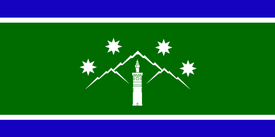Aghul people
Aghuls (Aghul: агулар/agular, Russian: агулы/aguly or агульцы/aguljcy) are a people in Dagestan, Russia. According to the 2010 census, there were 34,160 Aghuls in Russia (7,000 in 1959).[6] The Aghul language belongs to the Lezgian language family, a group of the Northeast Caucasian family. Ethnically, the Aghuls are close to the Lezgins. There are four groups of the Aghul people, who live in four different gorges: Aguldere, Kurakhdere, Khushandere, and Khpyukdere. Like their neighbors the Kaitaks, the Aghuls were converted to Islam at a fairly early date, subsequent to the Arab conquest of the eighth century. Their oral traditions claim Jewish descent.[7]
| Total population | |
|---|---|
| 35,000 (est.) | |
| Regions with significant populations | |
| 34,160[4] | |
| 108[5] | |
| Languages | |
| Aghul language | |
| Religion | |
| Sunni Muslims, non-denominational Muslims, Muwahhid Muslims | |
| Related ethnic groups | |
| Lezgins | |
Culture
Each Aghul village had a village council, on which each of the three or four tukhums were represented. The council was headed by an elder. The village mullah and qadi also played an important role in local affairs. In some cases the wealthier tukhums exerted a disproportionate strong influence on village government. As elsewhere in Daghestan, the Aghuls were divided into tukhums (clans), comprising twenty to forty households. Each tukhum had its own cemetery, pastures, and hay fields, and the members were bound by obligations of mutual support and defense.
The Aghuls tended to practice endogamy within the tukhum—marriages with outsiders were very rare. In the past the Aghuls lived in extended family households, though not especially large ones (fifteen to twenty members, on average). A senior male, father or eldest brother, functioned as chief, with fairly broad authority over the affairs of the household and its members. Should the extended family split up, sisters—even those who had already married and left the household—received a portion of the land as well as the movable property. They were each apportioned one-half of the land share given to each of their brothers, a practice that was unusually generous by Daghestanian standards.
References
- Флаги различных национальностей России
- Флаги национальностей России. Выпуск 12. Агульцы.
- (2002 census) Archived 2006-08-31 at the Wayback Machine
- Russian Census 2010: Population by ethnicity Archived 2012-04-24 at the Wayback Machine (in Russian)
- "About number and composition population of Ukraine by data All-Ukrainian census of the population 2001". Ukraine Census 2001. State Statistics Committee of Ukraine. Archived from the original on 17 December 2011. Retrieved 17 January 2012.
- Russian Census 2010: Population by ethnicity Archived 2012-04-24 at the Wayback Machine (in Russian)
- Peoples, Nations and Cultures. Edited by John Mackenzie. Weidenfeld and Nicolson 2005.
